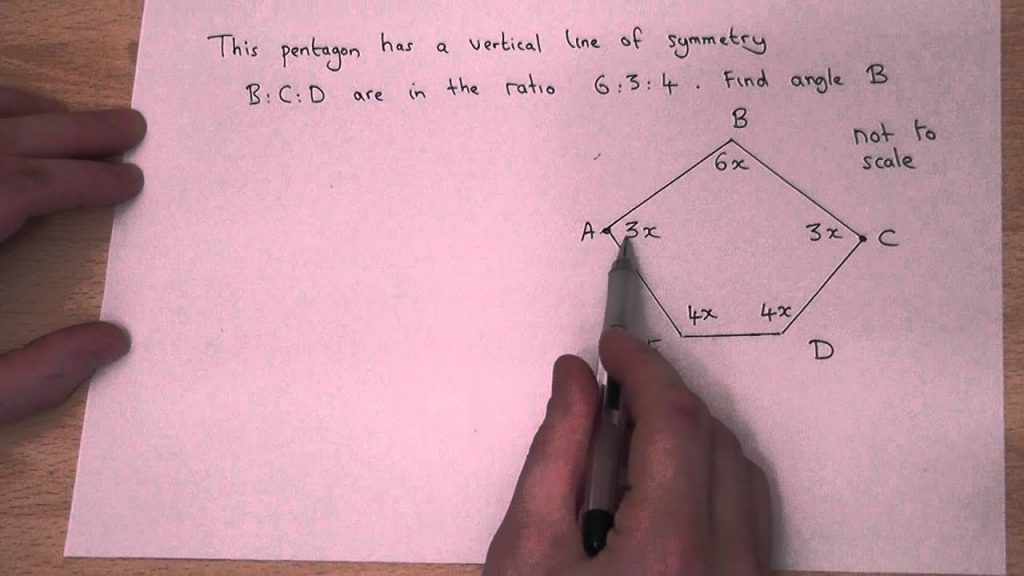Basics of Polygon
Before we start the pentagon, let us first refresh the definition of Polygon. Polygon has closed two-dimensional shapes which are made up of straight lines. These straight lines are known as sides or edges. The points where these lines join each other are known as vertices. These vertices eventually come from the angles of a polygon.
Any closed two-dimensional structure cannot be a polygon if even one of the sides is curved.
| Number of sides | Polygon name |
| Three | Triangle |
| Four | Quadrilateral |
| Five | Pentagon |
| Six | Hexagon |
| Seven | Heptagon |
| Eight | Octagon |
| Nine | Nonagon |
| Ten | Decagon |
General Properties of Polygon
As mentioned above, a typical Polygon can have “n” number of sides, which eventually impact the perimeter, angles (interior and exterior), and area.
- Perimeter: It can be defined as the sum of the sides of a polygon. For example, in the case of a triangle, it will be the sum of three sides, while in the case of a quadrilateral, it will be the sum of all four sides and so on.
- Area: It can be defined as the region covered by the sides of the two-dimensional polygon and is calculated differently for which polygon depends upon its type.
- Angles: Since in a polygon, sides join to form vertices, resulting in an angle formation. These angles can be further classified into two types as mentioned below:
- Interior angles: The angles present inside the polygon are known as interior angles. Their sum for any given polygon is represented by the formulae (n-2)*180°, where “n” represents the number of polygon sides. For example, the quadrilateral has 4 sides, then the sum of interior angles would be (4-2)*180° which is 360°. Similarly, for the pentagon, it would be 540°.
- Exterior angles: For each interior angle, there will be corresponding exterior angles two, and as a thumb rule, their sum will always be equal to 180° and can be represented by the formulae;
Interior angle Exterior angle = 180°
Based on the above information, now it is much easier to understand PENTAGON.
BASIC OF PENTAGON
The word pentagon is derived from the Greek word ‘pente’, which means ‘five’, and ‘gonia means ‘angle’. Pentagon is a geometrical flat 2-dimensional shape which we already discussed in the polygon. As the name signifies, it has five straight sides which join with each other to form five vertices. These five vertices eventually form five angles.
Properties of a pentagon
- Area of the Pentagon
As detailed above, the area is the region enclosed within the sides of the polygon. Thus, in the pentagon case, it is the area present within the five sides of the pentagon. The area of the pentagon can be represented mathematically by the formulae as shown below:
Area of a pentagon = ½ × perimeter × apothem
Apothem is the perpendicular drawn from the centre of the pentagon to one of its sides, or we can say apothem is the radius of the pentagon.
But if a pentagon with 5 equal sides and 5 equal vertices, then the area of the pentagon will be are of 5 equal triangles that can be carved out of the pentagon. This can be represented mathematically as shown below:
Area = 5 × area of a triangle
- The perimeter of a Pentagon
Perimeter, by definition, is the sum of all the sides. Hence, in the case of a pentagon, it is the sum of all the pentagon sides. If a pentagon has five sides represented as A, B, C, D, E, then perimeter can be represented as
Perimeter = A+B+C+D+E, and if all these sides are equal in length, such as A=B=C=D=E, then perimeter can be represented as
Perimeter = 5*(A/B/C/D/E) or perimeter is equal to the 5 times of any one of the lengths.
- We have already discussed angles in the polygon section, and mathematically it can be represented as (n-2)*180° where “n” represents the number of sides of the polygon. Since a pentagon has five sides, the sum of a pentagon’s angles is 540 degrees.
- In the pentagon case, if all the sides are equal in length, then the angles formed will also be equal. Hence the measure of exterior angles would be 540/5 = 108 degrees.
- Similarly, the measure of interior angle would be 180 degrees – Exterior angle = 72 degrees.
From the above discussion, we can conclude the following are the properties of the pentagon:
- The number of sides of a pentagon will be five
- The vertices of a pentagon will be five
- The number of angles will be five
- Exterior Angles in a Pentagon ( if all sides are equal) = 540/5 = 108 degrees
- Each interior angle of a pentagon = 180 degrees – Corresponding exterior angle = 72 degrees
- Diagonals of a pentagon will be five
- Perimeter = Sum of all five sides
- Area = ½ × perimeter × apothem
Types of a Pentagon
A pentagon can be broadly classified into four different types as mentioned below:
- Regular pentagon
- Irregular pentagon
- Concave pentagon
- Convex pentagon
A regular pentagon is a pentagon for which all five sides are equal. Since its sides are equal; hence the measure of the angles (internal/external) will be equal too.
An irregular pentagon is a pentagon for which all five sides are different in length. Since its sides are not equal; hence the measure of the angles (internal/external) will be different too.
Convex Pentagon is a pentagon in which vertex point towards outwards. Since no angle is pointing inwards, hence their measure can not be more than 180 degrees.
A concave pentagon is a pentagon in which at least one vertex points towards inwards. Since one of the vertexes is pointing inwards in a concave pentagon, one or more interior angles measure 180 degrees.
Conclusion
The word polygon is a combination of two words, i.e. poly which means many, and gonia which means angles. Depending upon the number of sides, the polygon can be of different shapes. This article reviews the formula and general rules of polygons.









